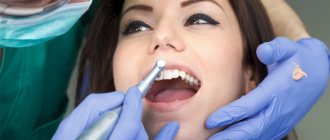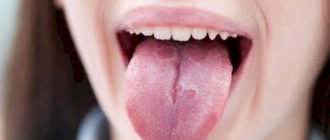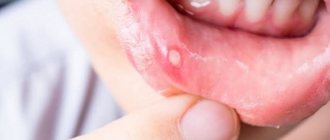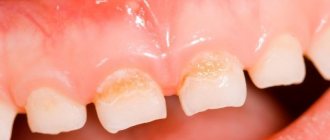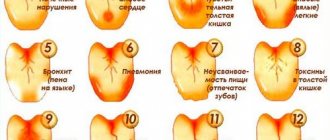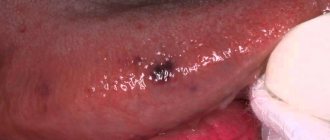Content:
- Features of the disease
- Causes of yeast glossitis
- How it manifests itself 3.1. Other symptoms of candidiasis on the tongue
- Treatment of tongue candidiasis 4.1. Medicines used for candidiasis 4.2. Traditional methods of combating oral candidiasis
- How to eat during treatment
- How to avoid getting sick
For the full functioning of all parts of the gastrointestinal tract, various fungi and bacteria must be present in the body.
They are called opportunistic pathogens. If their quantity corresponds to the norm, the person feels well and does not experience unpleasant symptoms of the disease. But under the influence of negative external or internal factors, bacteria and fungi can begin to actively multiply. Then their activity becomes abnormal - a disease of the oral cavity or stomach or intestines is diagnosed. It is in this scenario that candidiasis develops on the tongue, throat and cheeks. Let's look at how to treat it and what measures to take to avoid relapse after recovery.
Tests and diagnostics
To confirm the diagnosis, microscopic examination of crusts and other biological tissues, fluids or scrapings is carried out, depending on the location of the pathology. As a result, fungal mycelium is detected. It is quite important to identify the causative microorganism (PCR diagnostics, ELISA, cultural inoculation with quantitative monitoring can be used for this), since various types of fungi can exhibit resistance to antifungal drugs.
Additional studies include checking for gastrointestinal pathologies, diabetes mellitus and leukemia .
Carry out differential diagnosis:
- with eczema - characterized by the formation of weeping surfaces after the opening of the blisters, redness and swelling are more pronounced;
- with leukoplakia , manifested by the development of plaques and opacities of areas of the epithelium;
- with allergic, streptococcal stomatitis, cheilitis and other similar lesions of a different nature.
Features of the disease
With candidiasis, there is an active spread of fungi of the genus Candida. Most often it is Candida albicans. To identify the pathogen, doctors carry out laboratory diagnostics - microscopic and bacteriological examination of the mucous membranes of the mouth, scraping plaque from the tongue.
Oral candidiasis is usually classified into two types:
- Yeast stomatitis. Affects the cheeks, gums, and palate. The tissues become covered with a characteristic white coating that cannot be easily removed.
- Yeast glossitis. The source of infection is the tongue. His back is affected. Small deep grooves are formed on its surface, in which whitish masses are deposited.
Tongue thrush always has clear clinical symptoms. It leads to swelling and inflammation of the tissues, causing severe pain. It gets to the point that the patient cannot chew food or even drink normally. The situation is aggravated by bad breath, which cannot be masked in any way.
Pathogenesis
Yeast fungi in the human body are considered to be opportunistic microflora . They may be present in the microflora, and if the immune system is strong, then the fungal infection does not cause diseases, for example, urogenital, respiratory, skin, or, as in this case, the mucous membranes of the oral cavity. Normally, in almost 70% of the population, yeast fungi are present in the resident microflora; they are inactive and do not cause candida or other fungal diseases. Reproduction usually occurs by budding and spores. Proliferation occurs not due to the departure of daughter cells from the mother cells, but through elongation and formation of a pseudomycellar tree. As a result of vital activity, toxic substances are released that weaken the human immune system.
Model of a fungus cell of the genus Candida
alcohol and drug abuse, oncology, and the use of contraceptives contribute to imbalance of the oral microflora and excessive proliferation of opportunistic fungi . Fungus in the mouth is most often a superficial disease that affects the mucous surface of the cheeks, the corners and borders of the lips, the back of the tongue, the palate, etc., but with significant spread and penetration into the bloodstream it can cause systemic chronic and generalized disorders.
In neutropenic or severely ill patients, candidal fungal infection can enter the bloodstream, where it causes widespread visceral dissemination. Generalized mycosis can lead to candida sepsis and even death.
Causes of yeast glossitis
In most cases, the disease is a consequence of a weakened immune system. Therefore, more often than others, people who have suffered some kind of serious illness encounter it. Pathology also develops due to dysbiosis resulting from long-term antibiotic therapy, taking hormones or immunosuppressants.
Other reasons include:
- ulcerative glossitis/stomatitis not treated in a timely manner;
- frequent mechanical damage to the mucous membrane covering the tongue;
- deficiency of vitamins and minerals;
- liver dysfunction;
- disruption of the normal quantitative relationship between different fractions of blood proteins;
- thyroid diseases;
- oncology;
- frequent consumption of alcoholic beverages, smoking;
- deficiency of potassium in blood plasma;
- pregnancy, breastfeeding.
Tongue candidiasis also occurs as a result of direct contact with a carrier of the infection. This refers to the transmission of the disease during kissing, when using shared utensils. In newborn children, the cause of pathology is the passage of a sick mother through the birth canal.
Diet for fungus in the mouth
Antifungal Diet
- Efficacy: no data
- Terms: 3-6 months
- Cost of products: 1500-1600 rubles. in Week
In addition to complex antifungal treatment, patients are strongly recommended to follow a strict diet consisting of foods without vinegar, sugar, yeast and alcohol. in vitamins and strengthening the immune system is also recommended The menu should include bananas, onions, garlic, asparagus, chicory, olive oil, seafood, legumes, and buckwheat.
How it manifests itself
The disease is easily diagnosed, since its symptoms are clear and speak for themselves. Symptoms are the same in adults and children. The pathology develops according to the principle of dermatitis. The skin becomes inflamed, red, and mucous membranes swell. As the number of fungi increases, sores form. They are painful, covered with a white or yellowish coating. When trying to remove the latter, blood begins to flow.
Subjectively, the patient complains of:
- itching/burning on the affected areas of the tongue;
- pain when eating solid foods;
- bad breath;
- discomfort during a conversation.
Plaque found on mucous membranes consists of dead epithelial cells, fibrin, bacteria, and food microparticles. It can be located in small isolated areas or merge into volumetric circles. If measures are not taken in time to eliminate this symptom, the infection will spread to the throat and then to the internal organs.
The danger lies in the fact that candida multiplies very actively. They are able to penetrate into the deep layers of the mucous membranes of the mouth. Then the disease is difficult to treat, and the likelihood of relapse remains high.
As for the painful sensations that appear while eating, they are associated with severe tissue inflammation. The latter turn red and bleed. Any mechanical impact aggravates the situation.
If pain occurs when swallowing, it means that candidiasis has spread to the pharynx. A feeling of a lump in the throat indicates the appearance of voluminous film growths. This should not be allowed. The sooner treatment is started, the lower the risk of unwanted complications.
Other symptoms of candidiasis on the tongue
Other signs indicating the disease include:
- weakness, lethargy;
- increased body temperature;
- proliferation and enlargement of the papillae on the surface of the tongue;
- deterioration of taste or loss of the ability to recognize tastes;
- tissue swelling;
- decreased tongue mobility.
If these symptoms appear, you must make an appointment at a dental clinic.
Treatment of tongue candidiasis
The treatment regimen is selected taking into account the factor that provoked the development of the disease. The main goal of therapy is not just to destroy pathogenic flora, but also to strengthen the immune system and improve the functioning of the stomach and intestines. If this is not done, the likelihood of relapse will remain high.
If the disease is caused by long-term antibiotic therapy, taking hormones or steroids, as is most often the case, you need to reduce the dosage of drugs from these groups and at the same time start using antifungal tablets. B vitamins and immunomodulators have an excellent effect on the body during the treatment of tongue candidiasis.
Medicines used for candidiasis
It is impossible to get rid of fungi of the genus Candida that have multiplied on the mucous membranes of the tongue without medications. Medicines should:
- relieve inflammation;
- activate regeneration processes;
- reduce pain;
- destroy fungi;
- heal ulcers;
- reduce swelling.
For this purpose, dentists prescribe the following pharmacological groups:
- Antifungal. They act by destroying the cell membranes of the pathogen. They are manufactured in the form of tablets and capsules for oral administration.
- Antiseptics for mouth rinsing. They destroy viruses, fungi, bacteria, and create conditions for the restoration of healthy microflora.
- Gels and ointments with antifungal activity. Used strictly locally. They treat the surface of the entire tongue. They help remove swelling, minimize itching and burning. Excellent healing of existing wounds.
- Antiseptics in the form of aerosols. Very convenient to use. Suitable for use in public places. Characterized by a wide spectrum of action.
When treating candidiasis in the tongue, it is important to use exactly the drugs prescribed by the doctor. There is no need to exceed their dosage, as this may cause the opposite effect.
Traditional methods of combating oral candidiasis
If you really want to supplement drug therapy with herbal remedies, it is permissible to use:
- decoctions of anti-inflammatory herbs;
- alcohol tincture of propolis;
- soda solution.
These products should be used while rinsing the mouth.
Symptoms
Oral fungus has a pathological effect, which consists of damage to the mucous membranes of the oral cavity, on the red border of the lips (otherwise called cheilitis) and in the corners of the mouth. Damage to the mucous membranes in the mouth when the patient is in a weakened condition or after long-term antibiotic therapy can lead to acute catarrhal stomatitis .
Pathology usually manifests itself in the form of a hyperemic or even bluish surface of the mucous membranes and the formation of single white plaques. They look like they are glued on. The fungus in the mouth, the photo of which is presented below, initiates chronic atrophic changes in the structure of the epithelium.
Fungus in the mouth
In addition, in addition to white plaque, crusts and redness, white papules, unpleasant local symptoms may occur in the form of itching, changes in taste, pain and burning.
How to eat during treatment
Candida fungi multiply very quickly if a person eats a lot of sweets. Therefore, until complete recovery you need to stop eating:
- sweets;
- ice cream;
- baking.
Any alcoholic drinks are also prohibited.
Meat lovers should give preference to turkey and chicken. Buckwheat porridge is very useful - it contains many B vitamins. In order not to further irritate or injure the mucous membrane of the tongue, you should eat warm and well-chopped food.
Causes of fungus on the tongue - video
Candida yeast-like microorganisms are generally a normal part of the human microflora.
In small quantities they do not manifest themselves in any way for years, but accompanying factors can provoke their modification and rapid growth, that is, spread over the surface of the oral mucosa.
The following reasons accompany the activation of the pathogenic activity of the fungus on the tongue:
- immunodeficiency, as a self-sufficient illness or weakening of the immune system’s defenses during illness;
- pregnancy period (due to changes in hormonal levels, immunity, metabolic processes);
- long-term use of medications that have a depressing effect on the immune system (antibiotics, corticosteroids, cytostatics, etc.);
- lack of vitamins, namely groups C, B, PP;
- other diseases predisposing to thrush - diabetes, kidney disease, gastrointestinal tract, tonsillitis, tuberculosis, HIV, chronic infections;
- oncological diseases, as well as as a consequence of radiation therapy;
- smoking and alcohol abuse;
- injury to the mucous surface of the oral cavity and tongue;
- dental problems - caries, gum inflammation, wearing dentures, etc.;
- oral contraceptives, as well as by kissing, using common household items (toothbrush, dishes) from an infected person.
Immunodeficiency as a cause of fungus on the tongue.
How to avoid getting sick
Preventive measures include following simple rules:
- balanced diet;
- elimination of traumatic effects on the tissues of the tongue;
- taking an antifungal drug during a course of antibiotics and hormones;
- course use of immunomodulators;
- maintaining oral hygiene;
- timely treatment of emerging dental diseases.
People who take care of their dental health and visit the dentist twice a year are much less likely to experience tongue candidiasis. This is a proven fact. Therefore, do not ignore your doctor’s requests to come for preventive examinations.
Prevention
There are a number of preventive measures to prevent the development of fungus in the oral cavity, these include:
- regular visits to the dentist, at least 2 times a year;
- taking medications that strengthen the immune system and following a healthy, nutritious diet;
- compliance with the rules of oral hygiene - cleansing plaque with toothpaste and rinses 2 times a day;
- quitting smoking and alcohol;
- minimal consumption of foods high in sugar and yeast, these include baked goods and other bakery, confectionery products, beer, etc.
